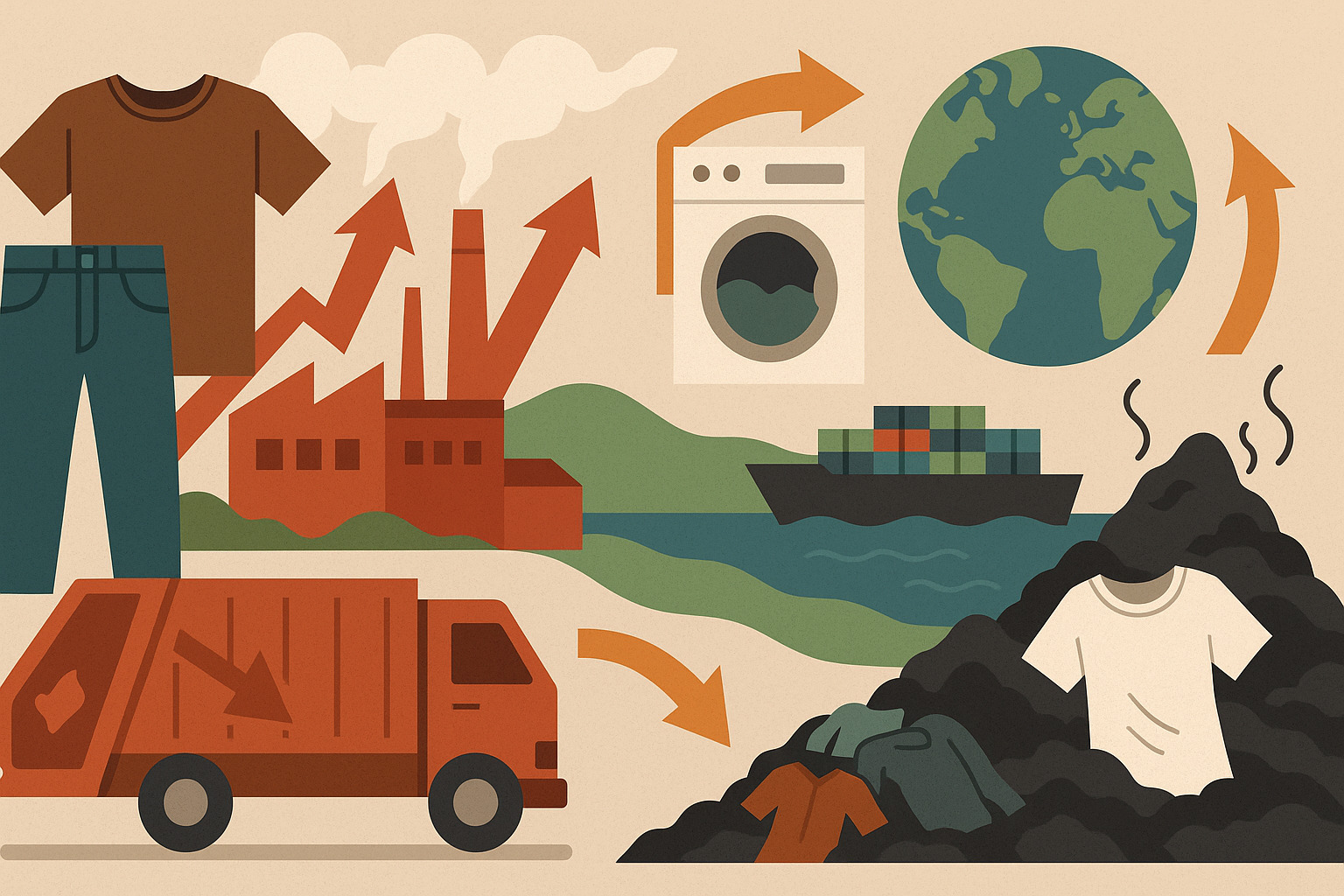The price tag on a garment doesn’t show the full cost. Behind a $10 shirt or a $40 pair of jeans lies a system fueled by high emissions, intense water usage, toxic chemicals, and mountains of waste. The fashion industry generates up to 10% of global carbon emissions, surpassing the emissions from all international flights and maritime shipping combined. As trends change rapidly, the planet pays the price.
How Fashion Becomes a Climate Offender
1. The Lifecycle Starts with Fibers
Every outfit begins with raw materials. Whether it’s cotton, polyester, or rayon, producing these fibers requires heavy resource input and releases substantial emissions.
- Synthetic Fibers: Polyester, nylon, and acrylic are made from petroleum. Their production is energy-intensive, releases toxic particulates, and contributes significantly to CO₂ emissions. Polyester alone consumes 70 million barrels of oil annually.
- Cotton: Conventional cotton, while natural, consumes excessive water and is sprayed with insecticides. It accounts for 22.5% of global insecticide use, grown on just 2.4% of farmland.
- Man-Made Cellulosic Fibers (MMCFs): Materials like viscose are made from wood pulp, requiring up to 4.5 tons of trees per ton of fiber, leading to deforestation and chemical runoff.
2. Energy-Heavy Manufacturing
Once fibers are made, they go through spinning, weaving, dyeing, and sewing. Each stage adds to the footprint.
- Spinning and Weaving: Account for over 75% of greenhouse gas emissions during manufacturing. Coal is the primary energy source in many textile-producing regions.
- Dyeing and Finishing: Use toxic chemicals and massive water volumes. Textile dyeing alone is responsible for 20% of global industrial water pollution.
- Garment Assembly: Adds another 20% to the emissions total and often occurs in factories powered by fossil fuels.
3. Transport, Retail, and the Global Supply Chain
The globalized nature of fashion stretches its footprint further.
- Transport: Fabrics and garments travel across multiple countries. This extensive shipping adds to emissions.
- Retail: The retail phase contributes around 3% of fashion’s carbon footprint.
Consumer Behavior Amplifies the Impact
4. Use Phase: Energy and Emissions at Home
Washing, drying, and ironing clothing accounts for 14% of the total climate impact.
- Washing synthetic garments sheds microplastic fibers into water systems, polluting rivers and oceans.
- A single laundry load can release up to 700,000 microfibers.
5. End-of-Life: Landfills and Incinerators
What happens after disposal matters.
- 85% of textiles end up in landfills or incinerated each year.
- Only 1% of clothing is recycled into new garments.
- Clothing waste is rising fast — from 92 million tonnes today to a projected 134 million tonnes by 2030.
The Fast Fashion Model: Fast Production, Faster Waste
Brands such as Zara, H&M, and Shein churn out new styles within weeks, pushing overconsumption and waste.
- The number of clothing items purchased per person has increased, while average usage per item has dropped by 36%.
- Clothes are worn fewer times and discarded quickly.
- This model relies on low-cost labor and cheap synthetic materials, intensifying environmental damage.
Hidden Environmental Costs Beyond Emissions
Water Consumption
- Fashion uses 93 billion cubic meters of water annually.
- A single cotton T-shirt consumes 2,700 liters of water.
- A pair of jeans requires about 2,000 gallons.
- Textile dyeing pollutes water sources with heavy metals, formaldehyde, and carcinogens.
Microplastic Pollution
- 35% of primary microplastics in the ocean originate from synthetic textiles.
- Equivalent to 500,000 tons of fibers annually, or 50 billion plastic bottles.
Biodiversity Damage
- Forests are cleared for viscose and pastureland for wool and leather.
- Pesticides used on cotton disrupt insect populations and soil ecosystems.
- Polluted waterways harm aquatic life and reduce biodiversity in key habitats.
What Needs to Change
1. Fiber Alternatives
- Organic Cotton: Uses less water and avoids harmful pesticides.
- Linen and Hemp: Require fewer chemicals and grow with minimal irrigation.
- Lyocell: A sustainable option that’s biodegradable and uses a closed-loop production system.
- Recycled Fibers: Reduce resource use and extend material life.
2. Cleaner Production Techniques
- Waterless Dyeing Technologies: Such as DyeCoo, reduce toxic runoff.
- Renewable Energy in Factories: Cuts reliance on coal and natural gas.
- Closed-Loop Systems: Reuse water and chemicals to minimize waste.
3. Circular Economy Adoption
- Design for Recyclability: Use fewer mixed fibers and detachable parts like zippers.
- Repair and Resale Platforms: Encourage consumers to reuse clothing longer.
- Rental Services: Offer access to fashion without the need for ownership.
4. Textile Recycling Innovation
Recycling faces technical challenges:
- Blended fabrics are hard to separate.
- Chemical finishes complicate reprocessing.
- Many recycled garments are downcycled into insulation or rags.
Scaling textile-to-textile recycling is key, but it currently comprises less than 0.5% of global fiber production.
5. Policy and Accountability
- Extended Producer Responsibility (EPR): Holds brands accountable for end-of-life garment management.
- Durability Standards: Encourage longer-lasting clothing.
- Chemical Restrictions: Limit hazardous substances in textile production.
6. Consumer Shifts
- Buy Less, Wear Longer: Choose timeless styles and quality materials.
- Wash Smarter: Lower washing frequency and temperatures to reduce microfiber release.
- Repair, Reuse, Repurpose: Extend garment life through maintenance and creativity.
7. Transparency and Anti-Greenwashing
- Brands should provide clear, verifiable data on environmental impact.
- Blockchain and digital tracking tools can help ensure supply chain traceability.
- Consumers should be wary of vague labels like “eco-friendly” without specifics.
The impact of fashion extends far beyond the checkout line. From petroleum-based fibers to microplastic pollution, every choice in the fashion supply chain carries environmental consequences. A shift toward slower, smarter consumption, cleaner production, and meaningful reuse can reshape the industry into one that supports both people and planet.
